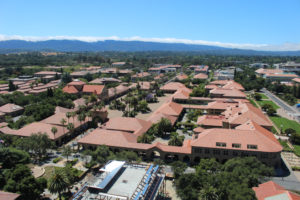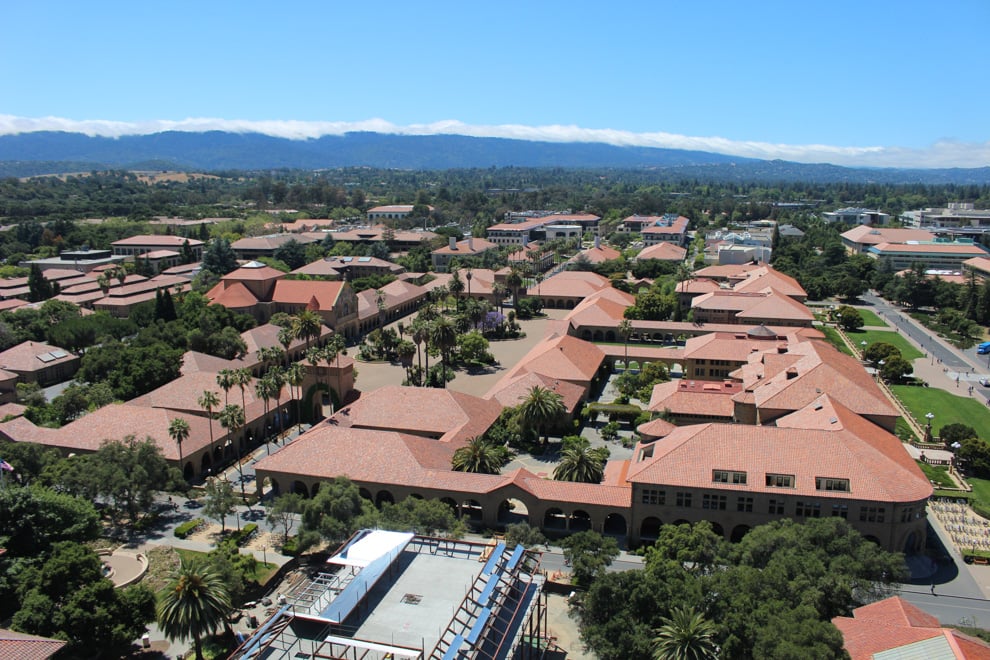Traffic, sustainability and staff housing emerged as key concerns at a Wednesday forum inviting community feedback on Stanford’s plans for campus development through 2035.
Stanford seeks to add nearly 2.3 million square feet of academic building space, 40,000 square feet of child care facilities and up to 3,150 units of housing as it renegotiates its General Use Permit (GUP), a land use agreement last updated in 2000. The University submitted its plans to Santa Clara County last November but must seek public input at multiple stages before it can get its vision approved.

Wednesday’s event at Palo Alto’s Mitchell Park Community Center, which drew about 100 attendees, was the first major opportunity for members of the broader local community to raise questions and give suggestions.
While Stanford promises no net increase in commute trips as a result of expansion, Palo Alto and Menlo Park residents wondered how adding thousands of beds to campus would affect traffic around their homes.
“The current traffic situation is pretty unbearable,” said Richard Dvorak ’81, who lives in the area. “There’s a gridlock all over Palo Alto … A lot of it is due to Stanford students, construction workers, staff … No net new commute trips may not actually be the right goal – maybe 10 percent reduction.”
Under the new GUP proposal, if Stanford does not meet its no-new-commutes goal, it will give money to support local transportation and traffic reduction programs. However, University officials at the forum noted that Stanford has not increased net commutes since 2001 and that transportation programs have decreased the drive-alone rate of Stanford commuters from 72 percent in 2004 to 50 percent today.
Many of the forum’s most vocal attendees were not traffic-weary neighbors but Stanford’s own employees and students. They pressed for greater sustainability and attention to Stanford’s impact on an already pricey local housing market. They also worried that Stanford’s push for increased campus housing and reduced commutes focuses on students and faculty while neglecting staff who cannot afford to live near the University.
“We’ve made Stanford a priority, and I don’t feel like Stanford’s made us a priority,” said Jenna Mains, finance manager for SEIU Local 2007, a union for service and technical workers in higher education that includes over 1,000 Stanford and SLAC employees.
Stanford’s new GUP proposal calls for 550 new faculty and staff housing units, which postdoctoral students and medical residents are also eligible for. Mains says 550 units is not enough for so many campus populations; less than 100 staff from her union live on campus.
“[Administrators] could probably afford to live elsewhere and they get the privilege of living on campus,” she said. “We have some workers who make $16 an hour and who have to live in Tracy.”
Commuting even from nearby East Palo Alto takes a financial toll for staff members who do not qualify for Stanford’s public transport subsidies, Mains said. Premium “A” parking passes for spots closest to buildings cost over $1,000 per year, while “C” passes for less convenient spaces go for $375. Mains hopes Stanford will become “more labor friendly” by expanding both housing and transportation opportunities for its staff.
Jean McCown, associate vice president of government and community relations, acknowledged that, historically, Stanford has prioritized students and faculty in its land-use planning. However, she noted 624 existing Stanford West apartments just off campus that are designated for other groups. Stanford is also proposing 215 apartments on University land in Menlo Park and will soon open 70 units in Palo Alto on El Camino Real, McCown added.
“We recognize there’s a need that goes beyond what we can build,” she said.
Union workers have the support of Stanford Coalition for Planning an Equitable 2035 (SCoPE 2035), a coalition of student groups that formed this school year to press environmental and social justice issues as Stanford’s moves through the GUP process. About 20 SCoPE 2035 members showed up at the community forum to make their concerns known and stand in solidarity with SEIU 2007 Local.
“[The GUP] is a really important thing to keep track of and to keep Stanford accountable to,” said Nayeli Altamirano ’19. “We’re here to follow them and let them know students are listening and care.”
Students’ questions for University officials ran a wide gamut of issues. One student called for Stanford to take its sustainability commitments even further by going carbon neutral, a suggestion that some Palo Alto community members seconded. Another asked if Stanford has assessed its impact on area housing prices. Others put their weight behind union workers’ plea for greater University attention.
Forest Peterson M.S. ’07 , a Ph.D. student, recounted a conversation with an SEIU 2007 Local member and Stanford dining worker who commutes from Livermore, about an hour away. He urged Stanford to enable more staff to live on campus with their children – a privilege he enjoys – so that his children “can go to school with her children.”
“Workers are part of our community and as such deserve [housing and transportation] opportunities that recognize this,” said one SCoPE member during the forum’s question session. “Many students here today have this at the front of our hearts and minds.”
Community members can email questions or comments to stanford2018GUP ‘at’ stanford.edu.
Contact Hannah Knowles at hknowles ‘at’ stanford.edu.
